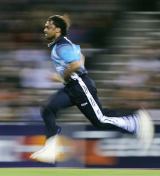Where goes Shoaib?
Everything that needs to be said about Shoaib Akhtar has already been said. And broadcast. And written. Many times over
Osman Samiuddin
08-Oct-2005
|
|

|
Everything that needs to be said about Shoaib Akhtar has already been said. And broadcast. And written. Many times over. When his mood is right, when his body is right, there is no sight in cricket more exhilarating, more likely to raise hairs. There are few bowlers in the world with a capacity as destructive as his. At all other times, he is difficult, his performances erratic. He is a maverick, a loose cannon, his own man and a hindrance to the team. Pakistan cannot do without him and they also cannot do with him. Ad nauseum it has all been said, broadcast and written, to the point, in fact, where his existence as a cricketer has ceased, replaced by clichés and crude caricature.
So here's something that's never been said about him before: one day before Pakistan's 58th birthday on August 14 this year, Shoaib turned 30. Thirty. It is a contemplative birthday in most walks of life, but with sportsmen, you suspect it might be more so as they begin to ponder a little harder about life, the universe and everything else beyond their profession. Generally, it is a natural moment for reflection and appraisal.
At 30, the two greatest fast bowlers Pakistan has produced - Imran Khan and Wasim Akram - had acquired substance. Their eventual worth was beginning to either unravel itself, as with Imran, or firmly in the process of being calculated, as with Akram. Imran had played 43 Tests and was eight wickets shy of 200. India was about to tour for a six-Test series that was to confirm him as, arguably, the premier fast bowler and all-rounder in the world. He had also displayed enough command and assertion by the sixth Test of his captaincy to hint that it could become the most influential in Pakistan's history.
His protégé Akram had played 67 Tests, was captaining Pakistan for the second time and on the threshold of 300 wickets. By then, he had won a World Cup final for his country, in itself a feat that has eluded the greatest of modern day players. He had bowled Pakistan consistently to wins around the world, legend had been thrust upon him and he was irrevocably established as one of the best ever to have hurled a ball with the left-arm. Despite 1996 being a fallow year for him, his place in Pakistan's - and possibly the world's - folklore had already been confirmed.
|
|

|
Where stands Shoaib, two months on from his 30th? Statistically - which admittedly is often enough a fickle barometer - he doesn't compare badly. Nearly eight years after his debut he has played 36 Tests and taken 144 wickets. Admittedly, Akram had played nearly double the number of matches at the same age, but, unlike Shoaib, as a teenage prodigy, he had been playing them since he was 18. After 36 Tests - a more just comparison perhaps - Akram had taken 133 wickets. Through one of those freak quirks that only statistics provide - and simultaneously makes you overlook their fickleness - Imran had taken, yes, 144 wickets after 36 Tests but at nearly four runs more per wicket.
At 30, has Shoaib acquired that same aura, that sense of formidability that coarsed through Imran and Akram? Reflexively and resoundingly you say no. He has, for a start, missed almost exactly half the Tests - 71 - Pakistan has played since his debut. Additionally, so disrupted has his career been that he has rarely completed a whole Test series; of the 21 he has participated in, he has played a full part in only seven. In two of those seven, he was rendered little more than a passenger through injury by the time of the last Test.
Quite simply he hasn't played enough - and continuously enough - for Pakistan, to have the sort of impact that warrants the query in the first place. That in itself is a condemnation but given the fiercely volatile set of extenuating circumstances - some inflicted on him and some of his own creation - under which his career has unfolded, maybe it is an unfair one.
Imran played a further 45 Tests after hitting 30; it could have been more but for his shin injury and it could have been less had he not been such a supremely fit athlete. Akram, prone to all manner of injury himself, played nearly 40 more Tests. Both, however, played enough to ensure that Pakistan's cricket history will forever owe a debt to them.
Shoaib's persistently chronic fitness troubles should lead inescapably to only one conclusion; that, at the age of 30, it is uncertain how many more matches and years he has in him. That deduction, in turn, should lead to one more; that at the age of 30, with eight years behind him, the impact Shoaib Akhtar has had and will have on Pakistan cricket is difficult to gauge.
Exactly half the people who read this conclusion will criticise it for singling out Pakistan's sole, genuine matchwinner. The other half will point to it as affirmation that he is a burden, and an overrated one at that; which come to think of it, are both sentiments that have been expressed before far too often.
Osman Samiuddin is Pakistan editor of Cricinfo